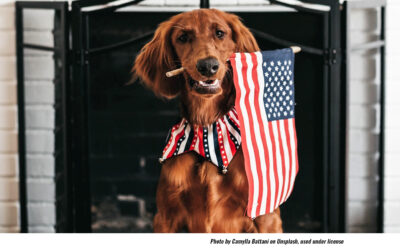Fireworks may be a blast to enjoy during the July 4th holiday, but experts agree they can scare pets.
“Although fireworks displays are an integral part of the holiday celebration for many people, they can be very distressing” for pets, Animal Services Manager Eric Anderson suggests. “Loud cracks and booms may cause animals to attempt to escape or run from the noise. In fact, many of these animals wind up lost and disoriented, brought into shelters, or even hit by cars when they run into traffic.”
Animal shelters across the country report they traditionally experience surges in intakes around Independence Day. That’s when animals frequently flee their yards and homes after being frightened by fireworks. Veterinarians and others suggest a few basic precautions that could help keep pets safe and minimize their risk of harm.
Six simple tips
Don’t take pets to fireworks displays. Even with their owner nearby, many animals will become agitated and stressed. They may injure themselves or others in attempts to escape.
Keep pets safe, in a quiet indoor location. If they will be unattended, remember they may become destructive when frightened. Remove any items they might damage, or which could be dangerous if chewed on. Leave them with some familiar, favorite items such as a chew toy or blanket.
Background sound might help. Leaving the radio or television on at a normal volume may be calming. It may also provide them with a sense of companionship.
Check with the vet. Owners with pets that are significantly upset by loud noises may want to talk with a veterinarian. Ask about ways to minimize their fear and anxiety. Some animals may benefit from the short-term use of mild sedatives.
Don’t leave pets outside alone. Even in a fenced yard, dogs that wouldn’t normally try to escape can panic and flee. Tethered animals can easily become entangled and injure themselves.
Identification and microchipping. Ensure pets are wearing a collar with up-to-date identification tags in case they get lost. Microchips are helpful for identifying animals brought into a shelter, but they won’t help neighbors or the public make direct contact if a pet is found.
Photo by Camylla Battani on Unsplash, used by Travels With The Post under license

 Lilacs Bloom and Cash Registers Ring in Rochester NY
Lilacs Bloom and Cash Registers Ring in Rochester NY